Cone Beam CT Identifies Various Causes of Hearing Loss, Dizziness
By MedImaging International staff writers
Posted on 17 May 2012
Cone beam computed tomography is better than mutidetector CT for detecting superior semicircular canal dehiscence (so-called third window; a small hole in the bony wall of the inner ear bone that can cause dizziness and hearing loss) and it uses half the radiation dose.Posted on 17 May 2012
The study, conducted in Bruges, Belgium, included 21 patients who had both a cone beam CT and a multidetector CT examination of their right and left temporal bones, according to David Volders, MD, and one of the authors of the study. Two radiologists reviewed the images from each of the scans and scored them based on image quality and the presence of pathology. The study found that cone beam CT “corrected a false-positive diagnosis for superior semicircular canal dehiscence in 11 out of 16 cases that were positive on multidetector CT [68.8%],” said Dr. Volders. Multidetector CT had indicated there was a dehiscence of the superior semicircular canal, when there was not, he said. Moreover, cone beam CT rated considerably better than multidetector CT in visualizing normal temporal bone anatomy, according to Dr. Volders.
“In our facility, all patients who undergo temporal bone imaging to diagnose fractures, congenital middle ear deformities, chronic ear infections, and conductive hearing loss are now scanned with cone beam CT,” said Dr. Volders. “The significantly better image quality and the very low radiation dose has made cone beam CT our main choice for temporal bone imaging,” he said. “Radiologists should closely follow the cone beam CT evolutions and consider a cone beam CT in their practice as new generation high end cone beam CT is more and more claiming its place in diagnostic imaging of the temporal bone,” Dr. Volders added.
The study’s findings were presented May 2, 2012, at the American Roentgen Ray Society (ARRS) annual meeting held in Vancouver (BC, Canada).
Related Links:
University of Maryland School of Medicine














